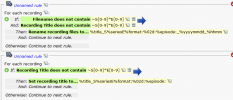Blather
After years of manually renaming downloaded files to contain SxxEyy and brief description, copied from the WebIF screen, then editing with TS-doctor to remove ads and fix up errors in files before xferring these to Plex I got to a point recently trying to dump a load we'd recorded during lockdown that we haven't got through yet. Bored of that process I finally got to "there must be a better way and it must have been done already". At least to get 90% done automatically with the rest flagged.
Didn't know about sweeper but found it searching through the forum, and while it's not hard in concept it's a little unclear from the instruction pages that I've found the best way to cope with real world issues such as "I've already processed these files and renamed them"
Thought I'd already got TVDB integration running but clearly didn't understand it was a manual process - I just thought it didn't do much.
Long Question
So... before I go trying to reinvent stuff has anyone got a canned solution to either the first 2 steps of my actual workflow or more if it's bombproof-
From a fully decoded set of files -
1. Rename all files to be Plex compliant (i.e. TV showname (sometimes year) SxxEyy Ep description or Film filmname (year of publishing) optionally Any other comments such as IMDB genre
2. Download all files to a local disk. I currently pull but push would be a good option. Optionally to create the text portion of the programme description to a similarly named file in the same directory as the main program.
3. Fix files and strip ads
4. Load to Plex.
Note, I've always been wary of auto ad stripping, the amount of time I have to spend making sure it's only stripping ads seems to negate the time spent doing it manually and we're not watching on the Humax boxes any more, they're headless in a room up in the attic. So bookmarks to flag potential ads don't seem to add much.
Shortened Question
What's the best method to make the decoded, recorded files available on an SMB file server with files renamed to reflect content incl show/film name, series, ep nos, ep name/description. Plus all text of the description avail to the humax in a text file with same name.
Thanks.
After years of manually renaming downloaded files to contain SxxEyy and brief description, copied from the WebIF screen, then editing with TS-doctor to remove ads and fix up errors in files before xferring these to Plex I got to a point recently trying to dump a load we'd recorded during lockdown that we haven't got through yet. Bored of that process I finally got to "there must be a better way and it must have been done already". At least to get 90% done automatically with the rest flagged.
Didn't know about sweeper but found it searching through the forum, and while it's not hard in concept it's a little unclear from the instruction pages that I've found the best way to cope with real world issues such as "I've already processed these files and renamed them"
Thought I'd already got TVDB integration running but clearly didn't understand it was a manual process - I just thought it didn't do much.
Long Question
So... before I go trying to reinvent stuff has anyone got a canned solution to either the first 2 steps of my actual workflow or more if it's bombproof-
From a fully decoded set of files -
1. Rename all files to be Plex compliant (i.e. TV showname (sometimes year) SxxEyy Ep description or Film filmname (year of publishing) optionally Any other comments such as IMDB genre
2. Download all files to a local disk. I currently pull but push would be a good option. Optionally to create the text portion of the programme description to a similarly named file in the same directory as the main program.
3. Fix files and strip ads
4. Load to Plex.
Note, I've always been wary of auto ad stripping, the amount of time I have to spend making sure it's only stripping ads seems to negate the time spent doing it manually and we're not watching on the Humax boxes any more, they're headless in a room up in the attic. So bookmarks to flag potential ads don't seem to add much.
Shortened Question
What's the best method to make the decoded, recorded files available on an SMB file server with files renamed to reflect content incl show/film name, series, ep nos, ep name/description. Plus all text of the description avail to the humax in a text file with same name.
Thanks.





